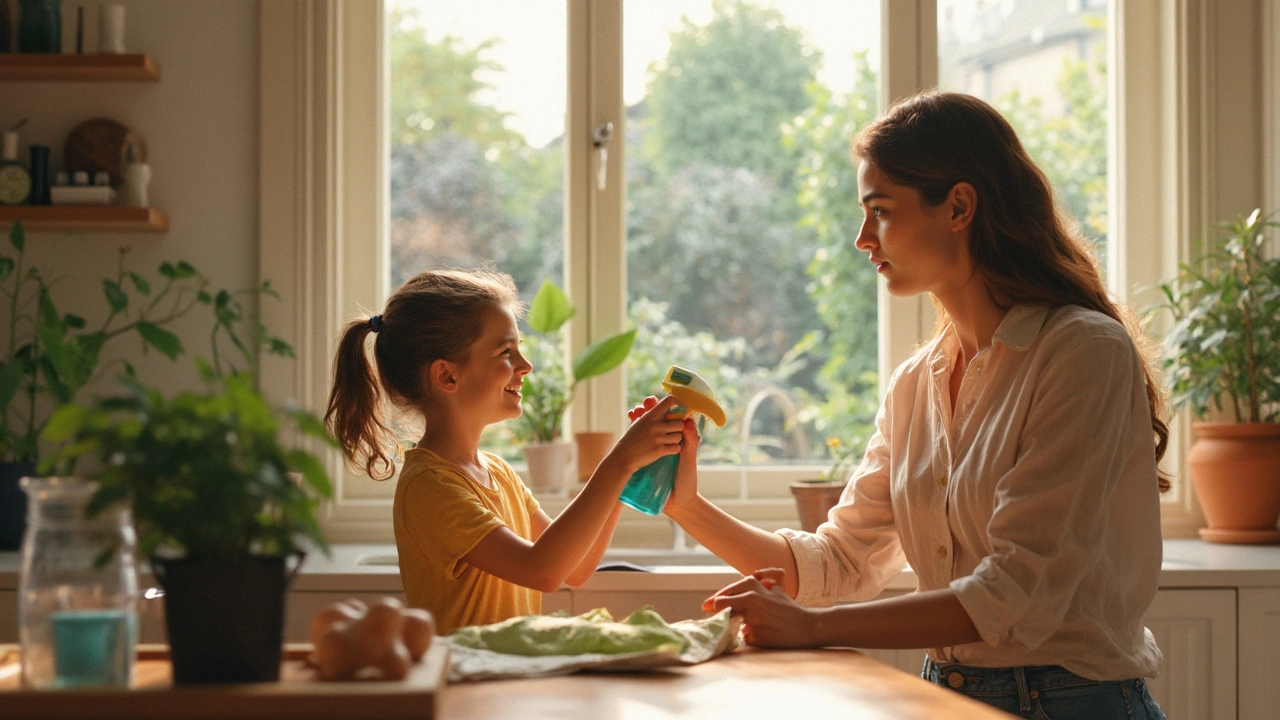Ever wonder why pro window cleaners leave glass spotless, while your DIY attempts end up streaky? The real secret isn’t some wild chemical—it’s a mix of smart ingredients and some know-how. Most pros don’t rely on fancy store bottles. Instead, they lean on a simple, tested solution: a dash of dish soap in a few gallons of water. Seriously, it’s that basic. A couple of pros might add a splash of vinegar or ammonia, but dish soap is the MVP because it breaks down grease without leaving a residue.
Don’t underestimate the water itself. The best window cleaners use cold or room-temperature water to avoid those dreaded streaks. If you live somewhere with hard water, a quick trick is to use distilled or filtered water. Keeps the minerals off your glass and saves you from annoying white spots later.
But here’s something most folks don’t realize: The cleaning solution is only half the magic. The real difference comes from using a rubber-bladed squeegee and a microfiber cloth to dry the edges. Forget about paper towels—they just smear things around. When you combine a simple DIY solution with the right tools, you’ll wonder why you ever spent money on those blue liquids at the store.
- What’s Really in the Pros’ Bucket?
- The Truth About Store-Bought Cleaners
- Why Tools Matter (Even More Than Solution)
- Mixing Your Own Pro-Grade Cleaner
- Tips the Pros Use Every Day
What’s Really in the Pros’ Bucket?
Okay, here’s what most pros actually have rolling around in their bucket—and this might surprise you. The average professional isn’t turning to some secret formula you can only buy from a specialty store. The real secret is how simple it is: a window cleaning solution made from just a bit of liquid dish soap mixed with lots of water. No, really. Sometimes they add a tiny amount of ammonia or vinegar if the glass is greasy or extra dirty, but too much of either one will leave streaks and smell up your house. That’s it for the solution itself.
Here’s what you’ll often find in a pro’s kit:
- Dish soap: Like Dawn or Fairy—just a few drops per gallon of water. Breaks down gunk fast and rinses clean.
- Water: Most use cold or room temperature. In places with hard tap water, they might use distilled water to avoid mineral spots.
- Optional vinegar or ammonia: Only for tough grime. Go light unless you want nose hair burns.
Just to let you see how common this is, take a look at a quick breakdown from what’s been surveyed among pro window cleaners in 2024:
| Ingredient | % of Pros Using |
|---|---|
| Dish Soap & Water | 89% |
| Vinegar (added to mix) | 21% |
| Ammonia (added to mix) | 7% |
So if you’ve got dish soap at home, you’re halfway there. The reason pros skip store-bought glass cleaner is simple: most of those have too much alcohol or additives that dry too quickly or leave streaks. By keeping it basic, pros get better results, faster, with less waste. If you want to mix it yourself, stick to one teaspoon of dish soap per two gallons of water and you’re golden. For super dirty windows, a splash of vinegar or ammonia does the trick, but don’t go overboard.
The Truth About Store-Bought Cleaners
If you’ve stood in the cleaning aisle staring at every bright bottle promising a streak-free shine, you’re not alone. Most store-bought glass cleaners use ammonia or alcohol as a main ingredient. This stuff cuts through grime fast and dries quickly—sounds good, right? But here’s what the labels don’t always shout: most pros skip them for daily use. Why? The fragrance and color don’t help clean your windows, and the harsh chemicals can annoy your nose or leave buildup on glass over time.
Here’s a quick look at some popular brands and what they actually contain:
| Brand | Main Ingredients | Added Features |
|---|---|---|
| Windex Original | Ammonia-D, alcohol, dye, fragrance | Marketed for streak-free finish |
| Sprayway Glass Cleaner | Isopropyl alcohol, perfume, surfactants | Aerosol foam, fresh scent |
| Seventh Generation Free & Clear | Plant-based alcohol, ethanol, water, surfactant | No dyes or synthetic fragrance |
The big problem with these big-name cleaners? Ammonia shots through your nose and lungs if you’re not careful. Plus, if you’re cleaning tinted windows or have little kids or pets pawing at the glass, the residue can be a pain.
- Most store-bought cleaners work fine for quick jobs or if you like a strong scent.
- If you want pro results, you’ll notice the shine fades faster and some products leave a light film, especially when used with paper towels.
- On sunny days, they can dry too fast, making streaks tough to avoid.
Bottom line—these cleaners get the job done in a pinch, but they’re not the top pick for window cleaning if you want that crystal-clear look. It’s not about brand loyalty, it’s just that the old-school, simple solutions used by pros cheap out on drama and go big on results.

Why Tools Matter (Even More Than Solution)
Everyone gets caught up searching for the perfect window cleaning mix, but the real game-changer is the gear you use. Every pro I’ve met swears by a few basic tools that do the heavy lifting, while the cleaning fluid just helps loosen up dirt. Try cleaning a big window with just paper towels and you’ll see why smears and lint stick around. It’s all about squeegees, scrubbers, and the right cloth.
Let’s break down the essentials:
- Squeegees: Invest in a good squeegee, with a sharp rubber blade. This tool is what removes all the liquid and muck in one smooth swipe, leaving windows crystal clear. Replace the blade as soon as it nicks or wears down, because one tiny tear will leave lines every time.
- Microfiber cloths: Ditch the old t-shirt and paper towels. Microfiber picks up what’s left behind after squeegeeing—think dust or drips around the edges—without scratching or leaving fluff.
- Scrubbers (or strip washers): This is what you use to actually loosen the dirt before you squeegee. It’s a soft sleeve on a handle. You’ll see the grime lift right off, especially on fingerprints or pollen-coated patio doors.
- Extension poles: Reaching the top of big windows without wobbling on a ladder? That’s the pro move. Extension poles fit both squeegees and scrubbers. Stay safe and clean faster.
One tip from the pros: Always keep your squeegee blade wiped dry for every pass. That’s what stops those annoying streaks that drive people nuts. And after you’re done, wash your gear. Dirty tools just smear, and that’s the quickest way to wreck a freshly cleaned window.
Bottom line—using the right tools saves time and actually makes the job easier. Even the perfect solution can’t compete with a worn-out squeegee or a linty rag. Gear up right, and it won’t matter if your cleaning day lands smack in the middle of your kid’s playdate or when the mother-in-law pops by to "inspect." Windows will be spotless, every time.
Mixing Your Own Pro-Grade Cleaner
Making the same window cleaning mix as the pros is surprisingly cheap and simple. Most experts agree: you don’t need fancy ingredients. You only need a few things you already have in your cleaning stash. Here’s what usually goes into a pro-level cleaning solution:
- 2 gallons of cold or lukewarm water (distilled if you have hard water)
- 2-3 teaspoons of regular dish soap (something like Dawn works best; avoid soaps with lotions or scents)
- Optional: 2 cups of white vinegar or 2 tablespoons of ammonia for an extra boost on really grimy, greasy windows
Why dish soap? Even companies that supply gear to commercial window cleaners recommend it. Dish soap lifts grease, bugs, and oily fingerprints without leaving streaks. Ammonia is for when there’s a season’s worth of grime, but skip it if you’ve got pets or small kids running around—vinegar is safer for homes.
Here’s how to mix and use your solution, step-by-step:
- Fill a clean bucket with 2 gallons of water.
- Add the dish soap (and vinegar or ammonia, if needed). Swirl gently to mix—don’t make it too sudsy.
- Dunk your scrubber or sponge, wring out excess so it’s not dripping everywhere, and get to work on the glass with steady, overlapping strokes.
- Finish each section with a rubber squeegee, wiping the blade with a microfiber rag between each swipe. This is key for that professional, streak-free window cleaning look.
Your hands won’t get wrecked by the soap, and there’s less odor compared to store-bought cleaners packed with chemicals. Plus, you save cash with every bottle you don’t buy.
Check this quick comparison of common window cleaning solutions pros use versus what’s in popular brands at the store:
| Solution | Main Ingredients | Cost Per Gallon (approx.) | Health Concerns |
|---|---|---|---|
| Pro DIY Mix | Dish soap, water, (optional: vinegar or ammonia) | $0.20 | Low |
| Store-Bought (Blue Cleaner) | Surfactants, color, fragrance, alcohol, ammonia | $3.50 | Can contain strong fumes |
| Vinegar-Based | Vinegar, water | $0.40 | Low, but strong smell |
You’ll notice the pro recipe costs way less, is milder, and honestly works just as well—if not better—than most bottles you’ll find at the grocery store. Easy, cheap, and it gets results. That’s why this is still the go-to mix for folks who clean windows for a living.

Tips the Pros Use Every Day
Professional window cleaners have routines and hacks that make glass cleaning way easier and faster than what most folks do at home. Here are some tricks they actually swear by on the job:
- Timing Matters: Avoid cleaning windows in direct sunlight. Sunlight makes the solution dry too fast and leaves streaks. Mornings or cloudy days are ideal.
- Use the Right Amount: Don’t overdo the soap. Just a small squirt—like a teaspoon per gallon—is all you need. Too much and you’ll get suds that leave film behind.
- Wipe Edges Immediately: After running a squeegee, always wipe window edges with a microfiber cloth to prevent drips or marks.
- Change Water Often: Pros swap out their water when it starts looking cloudy. Clean water delivers a better finish. If you have a lot of windows, consider splitting the job in half and refilling the bucket.
- Use Two Cloths: One for wet work and one dry for polishing. Professionals never use paper towels since they shed lint and aren’t absorbent enough.
- Work Top to Bottom: Always start at the top of a window and move down. That way dirty water can drip and get picked up as you go.
- Spot Tackle: For stubborn spots like bird droppings or tree sap, use a nylon scrubber pad that won’t scratch glass. Never use steel wool, unless it’s marked as safe for glass.
Here’s a quick look at some data pro cleaners pay attention to:
| Pro Tip | Why It Works | Common Mistake |
|---|---|---|
| Use a rubber squeegee blade | Leaves a streak-free finish with less effort | Old, cracked blades leave marks |
| Use a window cleaning solution with a drop of dish soap | Breaks up grime with no filmy residue | Overdoing the soap or using harsh cleaners |
| Work in overlapping strokes | Prevents missed spots and re-drips | Random wiping leaves patches behind |
| Polish corners and edges | Stops runs and watermarks | Ignoring the edges causes drips |
If you want windows that look pro-level, consistency matters more than fancy cleaners. These simple habits and routines can turn your next cleaning session into something the neighbors might actually notice.
